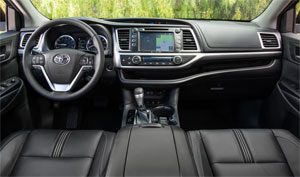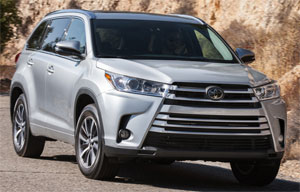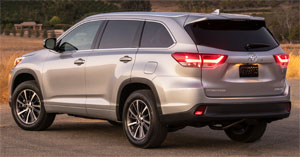2017 Toyota Highlander
Few brands have the SUV landscape covered as totally as Toyota. Even when it comes to large family duty, they have a trio to choose from. But it’s the Highlander crossover that picks up the bulk of that business, and its been updated for 2017 to give those families more of what they really want.
Now midway through its 3rd generation, the Toyota Highlander adds a multitude of updates for 2017. But don’t think they’re the hastily assembled kind of revisions in response to some sales slump, rather just the normal progression of keeping current with the segment. As despite a rash of recently re-engineered competition, the Highlander remains a top seller in the family 3-row utility world.
You don’t have to like the big mouth look, in fact most of our staff don’t; but you certainly won’t be able to ignore it, as it seems to be swallowing up as much road as possible while heading in your direction.
The big news for ’17 is new SE trim. It tames that front end somewhat with dark pieces replacing the usual chrome. 19-inch wheels are added as well, to support a sportier image.
 Fortunately, it doesn’t stop with looks. SEs also get a retuned suspension for a little more agility. Still, this is perhaps where Highlander shows its age the most, having a heavier feel compared to much of the competition who have moved on to lighter weight materials. But that also gives it a totally solid, safe, and secure feeling compared to many rivals.
Fortunately, it doesn’t stop with looks. SEs also get a retuned suspension for a little more agility. Still, this is perhaps where Highlander shows its age the most, having a heavier feel compared to much of the competition who have moved on to lighter weight materials. But that also gives it a totally solid, safe, and secure feeling compared to many rivals.
From the high seating position, drivers will be enjoying that enhanced nimbleness from new black leather seats with silver stitching. Of course its accompanied by dark dash and door trim.
Controls and layout are all very familiar, with no major changes here; including the very helpful storage in the dash. Good news for those with electronics to keep charged, all Highlanders now come with 5 USB ports!
Both 7 and 8-passenger versions are available, with the 2nd row seats remaining very comfortable and spacious. And while many competitors have stepped their game up in the 3rd row department, access here is still very good, though very low seat bottoms make for an awkward seating position.
 Cargo space continues to be good here; 13.8 cubic-ft. behind the 3rd row, 42.3 behind the 2nd, and a max of 83.7 cubic-ft. Boosting practicality further, the Highlander is one of the few SUVs that still has a flip up glass for the rear hatch; though only in upper trim levels.
Cargo space continues to be good here; 13.8 cubic-ft. behind the 3rd row, 42.3 behind the 2nd, and a max of 83.7 cubic-ft. Boosting practicality further, the Highlander is one of the few SUVs that still has a flip up glass for the rear hatch; though only in upper trim levels.
Even better news, is the arrival of a higher power. An enhanced version of the 3.5-liter V6 that gets a 25-horsepower boost to 295. Torque rises 15 lb-ft. to 263.
All this while actually improving fuel economy, thanks to a new 8-speed automatic transmission.
Government Ratings are now 20-City, 26-Highway, and 22-Combined with all-wheel-drive. Our average was 21.0 miles-per-gallon of Regular.
At the track, thanks to the upgraded V6, Highlander certainly feels less sluggish off the line. There’s a strong low end pull to get you going, while it eagerly delivers power on the high end as well. We hit 60 in 7.7-seconds; with a ¼-mile time of 16.0-seconds flat at 92 miles-per-hour.
 Base LE trim still comes with a 185-horsepower 2.7-liter I4, though in front wheel-drive only; and of course the Highlander Hybrid remains available as well.
Base LE trim still comes with a 185-horsepower 2.7-liter I4, though in front wheel-drive only; and of course the Highlander Hybrid remains available as well.
As for how the upgraded SE suspension handled our cones; well, there is still some mild understeer as you might expect, but the tauter suspension is very noticeable.
In fact, after a few runs, we were really hauling the goods, shaving ever closer to the cones and keeping speeds higher than we would have expected going in. Even body roll is well subdued; it was tire sidewall flexing that seemed to hold us back the most.
Of course it’s all about family safety these days; and for 2017, all Highlanders get Toyota Safety Sense P with automatic emergency braking as standard equipment.
Highlander pricing starts at just $31,625. New SE trim goes for $40,685, with all-wheel-drive adding another $1,460.
Even with the rapid pace of change these days, the Toyota Highlander has had no problem staying near the top the sales charts in the highly competitive 3-row crossover utility segment. Toyota fans will find more of what they love here in this upgraded 2017 version. And that should ensure current Highlander sales remain high, until an all-new one hits the streets.
Specifications
- Engine: 3.5 liter
- Horsepower: 295
- Torque: 263 lb-ft.
- 0-60 mph: 7.7 seconds
- 1/4 mile: 16.0 seconds @ 92 mph
- EPA: 20 mpg city / 26 mpg highway
2024 Toyota Land Cruiser
Toyota’s Go Anywhere Globetrotter Returns To U.S.
Every once in a while, we all need a reset. A time to get back to basics and prioritize the things that really matter. Well, for the Toyota Land Cruiser that time is now. So, let’s find out if that means bigger and better things for Toyota’s iconic off-roader.
The Toyota Land Cruiser’s status among the global off-road community is legendary, and it’s hard to imagine there’s any corner of the earth where a Land Cruiser hasn’t kicked up a little dust or mud. Well, 2024 sees the return of the Land Cruiser to the U.S. market after a 3-year hiatus, getting a major reset for the journey.
The reset comes mostly by no longer being based on the large three-row “300-series” chassis, but a new version of the smaller “200-series,” now known as the J250. As with the latest Tacoma, it uses the Tundra pickup’s full-size steel frame.
While the main Land Cruiser model, which goes by simply Land Cruiser, is packed full of luxury and convenience features, there is also a stripped-down model known as the 1958, honoring the first year the Land Cruiser made landfall here in North America. And it is that 1958 we have here, and we were glad to see it, as it also celebrates the original’s back-to-basics approach as a blank canvas for you to personalize as you tackle more and more adventures.
Not that it’s fully stripped down, as 8-inch touchscreen infotainment, a 7-inch full-color multi-information display, and automatic climate control are still standard. Plus, some seriously durable materials, and great heated cloth front seats that throw off some get serious 1990s Tacoma vibes.
But outside, there’s a definite lack of flashy trim and basic looking 18-inch wheels with Yokohama Geolander all-season tires; plus, big chunky bumpers and tilt-up back glass, which is a rarity that we appreciate. Though there is a little too much plastic in places that are sure to see some abuse if you do any significant off-roading.
It even feels a little rough around the edges, but for us it just adds to the rugged old-school utility vibe in a good way.
We did just that, both here in the Mid-Atlantic as well as in the California desert; and while there are some tech-forward driving aids, the actual hardware is in most cases plenty to get things done. That includes standard full-time dual-range four-wheel-drive, locking center and rear diffs, and 8.7-inches of ground clearance. A front stabilizer bar disconnect is also available to allow for increased articulation.
Who needs a V6 or even a V8 when you’ve got Toyota’s i-FORCE MAX setup at your disposal with 326 horsepower and 465 lb-ft of torque coming from a 2.4-liter turbo-four with an electric motor sandwiched between the engine and its eight-speed automatic transmission. Low speed torque delivery is impressive. It even feels a little rough around the edges, which may be a turn off to some, but for us it just adds to the rugged old-school utility vibe in a good way.
And it certainly feels quicker than an off roader needs to be, with an instant torque dump as soon as we eased on the throttle at our Mason Dixon test track; helping us get to 60 in 8.1 seconds and through the quarter-mile in 16.3 seconds at 86 mph. Considering the Land Cruiser’s terrain conquering mission, it behaved quite well in our handling course; it was plenty responsive to inputs, with less body roll than we expected and plenty of grip from the tires. The steering was light and quick but as expected didn’t provide much feel. Other than significant nosedive, braking performance was exceptional. Only 107-feet to panic stop us from 60 mph.
With the shift to the smaller size, there’s no more third row available, and cargo capacity now comes in at 46.2 cubic-feet with a max of a still healthy 82.1. Now, the best part of the Land Cruiser’s return is the entry price of $57,445. That’s about 30-grand less than what the last Land Cruiser went for back in 2021.
Whether it’s over the top fashion trends, mullets, or zombies; just when you think they’re dead, they come roaring back to life. Of course, we’re much happier to see the resurrection of this 2024 Toyota Land Cruiser than any of those things. Toyota is one brand that still recognizes the value of full-framed rugged rigs and has also acknowledged that sometimes less really is more. The Godfather of Toyota off-roading is back and better than ever.







